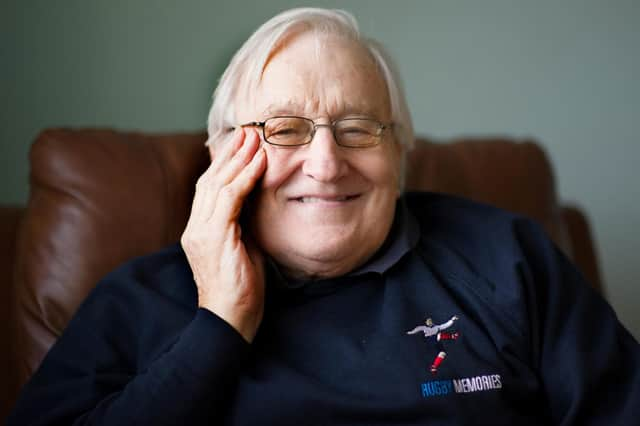XV-a-Side rugby column: Remembering Sandy Carmichael MBE


“I had last seen Davie at his wife’s funeral, but I noticed a big decline. I wasn’t quite prepared for what happened next. I was surprised- but pleasantly surprised. I had been asked by his daughter Lynne to go along to his house and meet a group of guys who were developing a project called Rugby Memories.
“Within a few minutes, I could see the effect it was having on Davie and soon we were recalling players, matches, tours, and visits- all by sharing the experiences that flowed by the images. Lynne had told me about the early successes of their first project called Football Memories, but quite frankly I was fairly sceptical until I saw it for myself.
Advertisement
Hide AdAdvertisement
Hide Ad“As we poured over the pictures, Davie simply lit up and the difference was quite spectacular and almost unbelievable. He pointed to players, smiled, and laughed and was clearly pleased to be able to recognise guys he had played with and against.
"After this one amazing session, I had no hesitation in agreeing to become involved with the work of the project as their first ambassador. I could see what it did for Davie, and I just knew that this project could help former players and rugby supporters in the most simple but effective of ways.”
Sandy Carmichael 2017.
Sandy’s rugby career started at school, and he was playing in the centre where he realised that he needed to tackle harder.
He moved into the forwards, initially in the second row, but was told he was too short and moved into the front row. By the end of his school career, he was captain of the 1st.XV and keeping fit during the summer months by taking part on the Highland Games circuit.
Advertisement
Hide AdAdvertisement
Hide AdHe always excelled in the sprints and relays, but also enjoyed the heavy events. While still at school, he played for West of Scotland Colts and enjoyed it immensely.
After school, he moved to West on a permanent basis and quickly settled in to the Second XV. His first team debut against Langholm came as a second row, and he proudly recalled the game, especially as he had kept Peter Brown out of the team.
Sandy moved into the front row and held his place in an immensely strong West team which contained International and District players.
One lasting friendship was made with a Maori All Black called Laly Haddon and years later, when the Lions visited New Zealand, Haddon was there at the airport to renew their acquaintance. One of Sandy’s team-mates was Davie Shedden.
Advertisement
Hide AdAdvertisement
Hide AdIt was at West that Sandy first met Davie Shedden, who had joined from Old Spierians in Beith.
Sandy recalled that he was a natural left winger, fast and utterly fearless, saying: “There was nothing to him, and he was like a whippet, especially over ten yards. He was also a good kicker, and he often bailed us out of trouble with massive touch kicks.
"He was as good a winger as any of his contemporaries and was only lacking in one department-weight.”
West had a star-studded side, yet the crowds were often disappointing considering the quality of rugby they played, and Sandy was sure there would have been bigger crowds if they had been located anywhere else.
Advertisement
Hide AdAdvertisement
Hide AdScotland selectors were often spotted at the games and some players knew when to move up a gear.
Gordon Brown in particular was always keen to impress if he thought a Murrayfield “spy” was watching and some of his friends used to wind him up pointing out imaginary selectors in the crowd. His performances at Burnbrae were soon noticed and he was chosen to play for Glasgow District - in the second row.
The district games were tough, as they faced all the major touring sides such as the All Blacks, the Springboks and the Wallabies. Inter-District games were not so intense but acted as a springboard for the Scotland side.
Sandy was selected to play in the Blues v Whites, and he knew a good performance was essential. He was included in the squad for training and his ability to play tight or loose head was a big advantage. He learned a lot from experienced players like Davie Rollo and in February 1967, he won his first cap, ironically as a late replacement for the injured Rollo.
Advertisement
Hide AdAdvertisement
Hide AdHis mother and father didn’t even know he was playing until they arrived at the game, and he ran out to form a front row of Carmichael, Laidlaw and McDonald. Ireland won 5-3 and Sandy had a good game.
Rollo returned for the England game at Twickenham, but Sandy’s next appearance was in December of that year in a match against The All Blacks, which is remembered for the dismissal of Colin Meads.
Sandy was determined to hold on to the jersey- literally. The players were given one jersey for the entire season and after several washes, the navy blue was more like a sky blue. Sandy had asked for a new jersey, but his pleas fell on deaf ears, until he was reluctantly given a replacement - but only for the official team photograph.
Receiving his first cap was a proud moment for his whole family and when he played his 50th game, he was presented with a special commemorative silver cap at an international dinner.
Advertisement
Hide AdAdvertisement
Hide AdHe was the first prop to be given such an honour and he often reminded us that he played all 80 minutes in his 50 games, unlike some players in the modern game, where the front row changes around the hour mark.